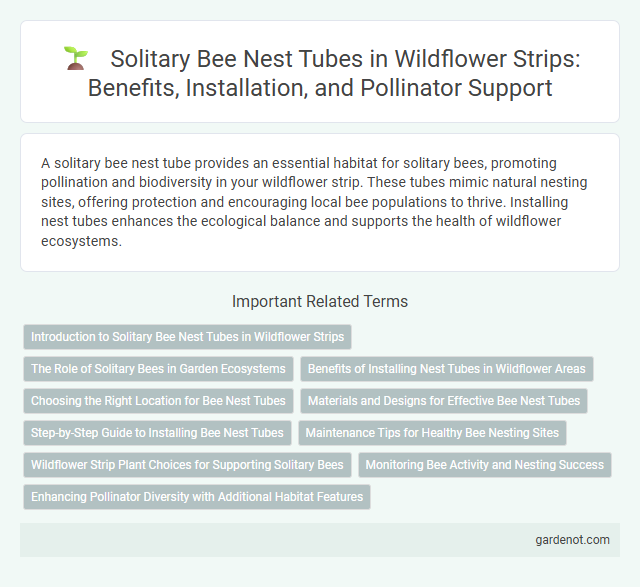A solitary bee nest tube provides an essential habitat for solitary bees, promoting pollination and biodiversity in your wildflower strip. These tubes mimic natural nesting sites, offering protection and encouraging local bee populations to thrive. Installing nest tubes enhances the ecological balance and supports the health of wildflower ecosystems.
Introduction to Solitary Bee Nest Tubes in Wildflower Strips
Solitary bee nest tubes provide essential nesting habitats within wildflower strips, supporting pollinator biodiversity and enhancing ecosystem services. These tubes mimic natural cavities, attracting solitary bees such as mason and leafcutter bees that are vital for pollination of wildflowers and adjacent crops. Integrating solitary bee nest tubes in wildflower strips promotes pollinator conservation and increases local plant reproduction and crop yields.
The Role of Solitary Bees in Garden Ecosystems
Solitary bee nest tubes provide essential habitats for solitary bees, which are vital pollinators in garden ecosystems. These bees contribute to plant reproduction and biodiversity by efficiently pollinating wildflowers and crops, enhancing overall garden health. Supporting solitary bees with nest tubes helps sustain their populations, promoting ecological balance and increased fruit and seed production.
Benefits of Installing Nest Tubes in Wildflower Areas
Installing solitary bee nest tubes in wildflower strips significantly boosts pollination efficiency by providing essential nesting habitats for native pollinators. These tubes help increase solitary bee population density, enhancing biodiversity and improving the reproductive success of wildflowers. By supporting solitary bees, nest tubes contribute to ecosystem stability and promote sustainable agricultural practices through natural pollination services.
Choosing the Right Location for Bee Nest Tubes
Selecting an ideal location for solitary bee nest tubes involves placing them in a warm, sunny spot sheltered from heavy winds and rain, typically 3 to 6 feet above ground to ensure optimal temperature and accessibility. Nest tubes should be positioned near wildflower strips to provide easy access to pollen and nectar sources, supporting the bees' foraging needs. Avoid shaded areas and proximity to pesticide-treated plants to maximize nesting success and bee health.
Materials and Designs for Effective Bee Nest Tubes
Solitary bee nest tubes are typically crafted from natural materials such as bamboo, reeds, or untreated wood, which mimic the bees' natural nesting habitats and provide optimal durability and ventilation. Designs often incorporate varied tube diameters between 4-10 mm to accommodate different solitary bee species, while features like removable end caps facilitate easy cleaning and maintenance to prevent parasite buildup. Effective bee nest tubes balance protection from moisture and predators with breathable construction, enhancing nesting success in wildflower strips.
Step-by-Step Guide to Installing Bee Nest Tubes
Select a sheltered location with minimal wind exposure for installing solitary bee nest tubes, ensuring direct sunlight in the morning. Secure the tubes horizontally at a height of 3 to 6 feet above the ground, spacing them at least a few inches apart to prevent crowding and facilitate easy access for bees. Regularly inspect and clean the tubes after the nesting season to prevent parasite buildup and increase hive health for the following year.
Maintenance Tips for Healthy Bee Nesting Sites
Regularly clean solitary bee nest tubes by removing debris and replacing damaged materials to prevent mold and parasites. Position nest tubes in a dry, sheltered location facing southeast to maximize sun exposure and warmth. Inspect tubes annually and avoid using pesticides nearby to maintain a healthy environment for solitary bee populations.
Wildflower Strip Plant Choices for Supporting Solitary Bees
Selecting native wildflower species such as Echinacea, Lupinus, and Monarda enhances solitary bee nesting by providing abundant pollen and nectar sources. Incorporating a diverse range of bloom times ensures continuous forage availability, crucial for supporting various solitary bee species throughout their active seasons. Strategically planting wildflowers in dense, pesticide-free strips near solitary bee nest tubes improves habitat quality and nesting success.
Monitoring Bee Activity and Nesting Success
Solitary bee nest tubes provide critical data for monitoring bee activity and nesting success by allowing researchers to observe emergence rates and occupancy patterns directly. Tracking the number of eggs laid, larval development stages, and adult bee emergence helps quantify reproductive success and population health in wildflower strips. Detailed monitoring of nest tube contents reveals insights into habitat quality, foraging resource availability, and the effectiveness of conservation strategies targeting solitary bee populations.
Enhancing Pollinator Diversity with Additional Habitat Features
Solitary bee nest tubes placed within wildflower strips increase pollinator diversity by providing essential nesting sites for solitary bee species, which are key pollinators in many ecosystems. Incorporating a variety of tube diameters and materials mimics natural habitats, attracting a broader range of solitary bees and boosting pollination efficiency for wildflowers. Enhanced nesting opportunities support population stability and improve the overall health of pollinator communities within these conservation areas.
Solitary bee nest tube Infographic

 gardenot.com
gardenot.com